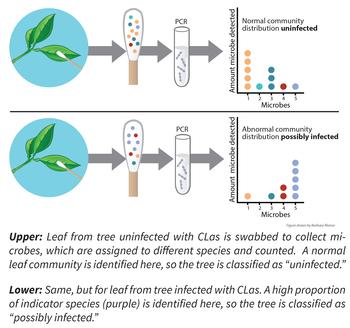Changes in microbial communities on citrus leaves can help detect HLB

Article written by Johan Leveau, Brianna McGuire, Elizabeth Grafton-Cardwell, Peggy G. Lemaux, & Lukasz Stelinski.
Revised November 6, 2017.
What is the technique?
There are measurable differences between healthy citrus trees and citrus trees infected with the bacterium Candidatus Liberibacter asiaticus (CLas), that causes huanglongbing disease (HLB). The most obvious difference is the presence of CLas DNA in infected plants. Polymerase Chain Reaction (PCR) is a test that can detect CLas DNA and is currently the only way to confirm the presence of the bacterium in trees. However, PCR-based methods are costly and are typically used only to confirm CLas presence in suspect trees, rather than screen large numbers of trees for CLas infection. To reduce costs and so increase surveying, there is much interest in developing an alternative method of CLas detection, especially methods that take advantage of the tree-wide changes that occur upon infection. Research in the laboratory of Johan Leveau in the Department of Plant Pathology at UC Davis found that microbial communities living on the surface of citrus tree leaves change during CLas infection. Leveau’s team collects microbes from foliage by swabbing leaves, uses DNA-based methods to profile the bacteria and fungi that are present on the swab sample, and compares the profiles of CLas-infected and uninfected trees.
How can microbes be used to identify infected trees?
When a tree becomes infected with CLas bacteria, it responds by changing the chemical composition of its leaves, which in turn impacts the microorganisms that live on the leaf surface. Not all microorganisms are impacted equally, thus causing a shift in the microbial community: for some bacterial or fungal species the numbers go up, for others they go down. This shift can be measured after swabbing the leaves to collect the microbes, followed by extraction of bacterial and fungal DNA from the swab, and analyzing the DNA for the presence or absence of fungal or bacterial species. Some species are known to become more abundant after CLas infection, and these species, known as indicators, are the ones that may help determine whether a tree is infected with CLas and detect it early in its infection. This method is non-destructive to the tree and would allow for rapid processing once indicator microbes have been identified. Ideally, this method will function as a pre-diagnostic tool that helps prioritize trees for follow-up testing for CLas by PCR.
Who is working on the project?
Johan Leveau, is a Professor of Plant Pathology at the University of California, Davis. His research team uses these methods to identify and validate microbe indicators for early detection of HLB.
What are the challenges and opportunities?
The biggest challenge for this technique is finding microbial species that are true indicators of CLas infection, irrespective of the time of year, the region that the tree is grown in, the cultivar of the tree, the stage of infection of the tree, or the age of the tree. Therefore, microbes from a wide variety of trees and tree locations need to be analyzed. Many candidate taxa have already been identified as potential indicators of CLas infection but more testing is needed. Fortunately, more testing is on the immediate horizon. The Leveau lab’s early detection technology is currently being field-tested in several different screenings of healthy trees, trees infected with pathogens other than CLas, and trees infected with CLas. Combining the microbial swab test with other techniques, such as an antibody-based detection of indicator species, may increase the accuracy and volume of samples that can be used with this test.
Funding source: This project is funded by the Citrus Research Board.


